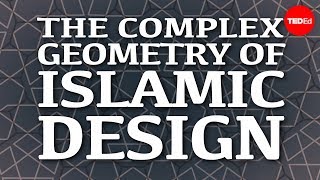(单词翻译:单击)
In Islamic culture, geometry is everywhere.
在伊斯兰文化中,几何无处不在。
You can find it in mosques, madrasas, palaces and private homes.
在清真寺、宗教学校、宫殿和私人房屋里,你都能觅得它的踪迹。
This tradition began in the 8th century CE during the early history of Islam,
这个传统始于公元8世纪的伊斯兰教早期,
when craftsmen took preexisting motifs from Roman and Persian cultures and developed them into new forms of visual expression.
那时的工匠们借鉴了罗马和波斯文化中已经存在的图案,用它们转化出新的的视觉效果。
This period of history was a golden age of Islamic culture,
这段历史时期是伊斯兰文化的黄金年代,
during which many achievements of previous civilizations were preserved and further developed,
在此期间,许多早期文明的成果都被保存和进一步发展,
resulting in fundamental advancements in scientific study and mathematics.
带来了科研和数学的显著提升。
Accompanying this was an increasingly sophisticated use of abstraction and complex geometry in Islamic art,
随之而来的便是伊斯兰艺术中对抽象和复合几何愈发熟练的运用,
from intricate floral motifs adorning carpets and textiles,
从装饰着复杂花卉图案的地毯和纺织品,
to patterns of tilework that seemed to repeat infinitely, inspiring wonder and contemplation of eternal order.
到看似无限重复的瓷砖图案,引人惊叹,激发对永恒次序的遐想。
Despite the remarkable complexity of these designs,
这些设计看起来很复杂,
they can be created with just a compass to draw circles and a ruler to make lines within them.
其实只需要一个圆规和一把在圆里画线的直尺就可以创造。
And from these simple tools emerges a kaleidoscope multiplicity of patterns.
而且从这些简单的工具中诞生了千变万化的图案。
So how does that work? Well, everything starts with a circle.
这是怎么做到的呢?嗯,一切都是从一个圆开始的。
The first major decision is how will you divide it up?
首先,你要决定准备如何分割它?
Most patterns split the circle into four, five or six equal sections.
大多数图案把圆分成四个、五个或六个部分。
And each division gives rise to distinctive patterns.
每次分割都增加了图案的独特性。
There's an easy way to determine whether any pattern is based on fourfold, fivefold, or sixfold symmetry.
有一个简单办法判断图案是基于四重、五重还是六重对称。
Most contain stars surrounded by petal shapes.
许多图案包含花瓣环绕的星星。
Counting the number of rays on a starburst, or the number of petals around it, tells us what category the pattern falls into.
数数星星有几个角,或者多少片花瓣,就能知道这个图案属于哪种类型。
A star with six rays, or surrounded by six petals, belongs in the sixfold category.
一颗有六个角或被六片花瓣包围的星星,就属于六重对称。
One with eight petals is part of the fourfold category, and so on.
八片花瓣也属于四重对称,以此类推。
There's another secret ingredient in these designs: an underlying grid.
这些设计还有一个秘方:一个隐藏的坐标格。

Invisible, but essential to every pattern,
虽然看不见,但对每个图案都很重要,
the grid helps determine the scale of the composition before work begins,
在创作开始之前,用这个坐标格确定构图的比例,
keeps the pattern accurate, and facilitates the invention of incredible new patterns.
保证图案的准确性,有助于创作伟大的新图案。
Let's look at an example of how these elements come together.
让我们看一个这些元素是怎样结合到一起的例子。
We'll start with a circle within a square, and divide it into eight equal parts.
我们先在正方形里画一个圆,把它八等分。
We can then draw a pair of criss-crossing lines and overlay them with another two.
然后我们可以画一对交叉线,在它们上面再画一对。
These lines are called construction lines, and by choosing a set of their segments,
这些线叫作图线,从中选取一部分,
we'll form the basis of our repeating pattern.
就成了的重复图案的基础。
Many different designs are possible from the same construction lines just by picking different segments.
从相同的作图线中,只要选择不同的部分就能得到许多不同的设计。
And the full pattern finally emerges when we create a grid with many repetitions of this one tile in a process called tessellation.
通过一个叫“密铺”的过程,作图线组在网格中多次重复,最终就形成了完整的图案。
By choosing a different set of construction lines, we might have created this pattern, or this one.
通过选一组不同的作图线,我们可能会得到这个图案,或者那个。
The possibilities are virtually endless.
可能性无穷无尽。
We can follow the same steps to create sixfold patterns by drawing construction lines over a circle divided into six parts,
通过同样的步骤还可以创作六重图案,只要让作图线把圆分成六份,
and then tessellating it, we can make something like this.
然后密铺,就能得到这样的东西了。
Here's another sixfold pattern that has appeared across the centuries and all over the Islamic world,
几个世纪以来,这个六重图案一直流行于伊斯兰世界,
including Marrakesh, Agra, Konya and the Alhambra.
包括马拉喀什、阿格拉、科尼亚和阿罕布拉。
Fourfold patterns fit in a square grid, and sixfold patterns in a hexagonal grid.
四重图案很适合方形网格,六重图案和六边形网格很配。
Fivefold patterns, however, are more challenging to tessellate because pentagons don't neatly fill a surface,
五重图案则是密铺的一大挑战,因为五边形不能铺满一个平面,
so instead of just creating a pattern in a pentagon, other shapes have to be added to make something that is repeatable,
所以为了能重复,除了五边形,还要加入其他形状,
resulting in patterns that may seem confoundingly complex, but are still relatively simple to create.
这就形成了更复杂的令人目眩的图案,但创作起来仍然比较容易。
Also, tessellation is not constrained to simple geometric shapes, as M.C. Escher's work demonstrates.
所以,密铺并不限于简单的几何图形,就像M·C·埃舍尔的作品那样。
And while the Islamic geometric design tradition doesn't tend to employ elements like fish and faces,
虽然鱼和脸谱这样的元素不符合伊斯兰几何设计的传统,
it does sometimes make use of multiple shapes to craft complex patterns.
但有时多用几种形状,确实有助于创造复杂图案。
This more than 1,000-year-old tradition has wielded basic geometry
这项有一千多年历史的与基本几何共舞的传统,
to produce works that are intricate, decorative and pleasing to the eye.
给眼睛带来了错综复杂的美妙享受。
And these craftsmen prove just how much is possible with some artistic intuition, creativity, dedication and a great compass and ruler.
而这些工匠也证明了一点艺术直觉、创造力、热情以及一个大圆规和一把直尺,能带来多大成就。


